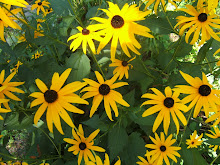I have lots of pulmonaria plants but they all originated from a couple of plants that came from my mother's garden that came from her mother's garden. They've been growing for about forty years at our property (yikes! that's a long time!) and the last few years I've been noticing more variation in the plants. The photo above is the typical bloom cluster with a range of purple and pink tones with fairly spotty leaves.
Here's a plant with almost all purple flowers.
A cluster of cerise blooms.
Two plants - one with darker pink, one with pale pink.
I like the delicate pink of this plant.
The leaves of this plant have very little spotting.
This one is very spotty and the spots are pretty round.
These spots are so intense they look raised.
And finally a plant where the blotches have blended so much the leaves are almost white.
Pulmonaria is easy to grow especially if you have heavy soil. They like to be in partial shade and will droop in hot afternoon sun. They can get powdery mildew but it won't kill them. They are great for bumblebees in the spring. They can be too vigourous and spread more than you want, but they are shallow rooted and unwanted plants are easily dug up. Some people find the slightly prickly leaves irritating to the skin but I've never had issues with them.
Pulmonaria is one of my favourite plants.I think the spotty leaves are so cheerful and the spring flowers are wonderfully colourful after the dullnes of winter.
The mystery plants from the last two posts are orange campion. I'm absolutely sure about that! I didn't think they would make it through the winter so I kind of forgot about them, but they came through with flying colours. They'll bloom in late June.
Subscribe to:
Post Comments (Atom)










There was rather a lot of it in my mother's garden and it seemed to do well even in the shady part of the plot where not much else would flourish. That had also been there for over 40 years and had several variations.
ReplyDelete